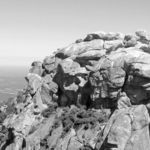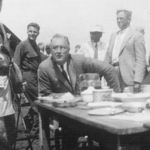 |
 | |
  | |
|
|
|
|
Shenandoah National Park
History & Culture
|
|
|
|
|
| |
 |
 |
| NPS Photo | |
 |
The oldest rocks in the Blue Ridge Mountains were created over a billion years ago as magma deep within the earth's crust moved upward. Over eons it cooled, fractured, and was joined by younger metamorphic rocks formed from sedimentary deposits. All were altered and eroded to shape today's granite peaks and sylvan hollows.
|
_150.JPG) |
| NPS Photo | |
 |
Around 8,000-9,000 years ago, but seconds in geologic time, the first traces of humans were recorded on the land that would become the park. Native Americans seasonally visited the area to hunt, to gather nuts and berries, and to find sources for and to make their stone tools.
|
 |
| NPS Photo | |
 |
Europeans first experienced the beauty of these mountains less than 300 years ago. First came hunters and trappers, and soon after 1750 the first settlers moved into the lower hollows near springs and streams. Over the next century and a half many hundreds of families built homesteads, mills and stores and planted orchards and crops. The mountains were logged and minerals were mined. Vacation resorts were established to allow guests to experience the mountain views, healthy water, and cool breezes. And American Society became urban, industrial, and yearned for special places for recreation and refuge.
In the early 20th century the first calls for National parks in the east were heard in the United States Congress. It would be two decades before Shenandoah National Park was authorized and another ten years before it was established. During that time President and Lou Henry Hoover established their Summer White House on the Rapidan River, the construction of Skyline Drive began, the Civilian Conservation Corps was established and moved into the park area, and over 450 families of mountain residents were relocated from the Blue Ridge.
|
 |
| NPS Photo | |
 |
With the establishment of the park in December 1935, the CCC began to build visitor facilities throughout the mountain, areas that were initially racially segregated. The core of the park's development was completed by the beginning of WWII and, to a great extent, the mountains were released to nature.
|
|  |  |
|
|

Visit the on-line bookstore
to find books such as... "The Greatest Single Feature...A Skyline Drive"
more... | |
|
|
|
|
|
|
|
 |
|
Did You Know?
Benton McKaye, the “father of the Appalachian Trail,” was also instrumental in passage of the Wilderness Act. Shenandoah National Park carries on Benton McKaye’s legacy with 101 miles of the Appalachian Trail and almost 80,000 acres of designated wilderness.
more...
|
|
|
|
Last Updated: January 22, 2007 at 12:07 EST |






